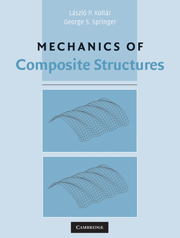Book contents
- Frontmatter
- Contents
- Preface
- List of Symbols
- 1 Introduction
- 2 Displacements, Strains, and Stresses
- 3 Laminated Composites
- 4 Thin Plates
- 5 Sandwich Plates
- 6 Beams
- 7 Beams with Shear Deformation
- 8 Shells
- 9 Finite Element Analysis
- 10 Failure Criteria
- 11 Micromechanics
- Appendix A Cross-Sectional Properties of Thin-Walled Composite Beams
- Appendix B Buckling Loads and Natural Frequencies of Orthotropic Beams with Shear Deformation
- Appendix C Typical Material Properties
- Index
2 - Displacements, Strains, and Stresses
Published online by Cambridge University Press: 01 September 2009
- Frontmatter
- Contents
- Preface
- List of Symbols
- 1 Introduction
- 2 Displacements, Strains, and Stresses
- 3 Laminated Composites
- 4 Thin Plates
- 5 Sandwich Plates
- 6 Beams
- 7 Beams with Shear Deformation
- 8 Shells
- 9 Finite Element Analysis
- 10 Failure Criteria
- 11 Micromechanics
- Appendix A Cross-Sectional Properties of Thin-Walled Composite Beams
- Appendix B Buckling Loads and Natural Frequencies of Orthotropic Beams with Shear Deformation
- Appendix C Typical Material Properties
- Index
Summary
We consider composite materials consisting of continuous or discontinuous fibers embedded in a matrix. Such a composite is heterogeneous, and the properties vary from point to point. On a scale that is large with respect to the fiber diameter, the fiber and matrix properties may be averaged, and the material may be treated as homogeneous. This assumption, commonly employed in macromechanical analyses of composites, is adopted here. Hence, the material is considered to be quasi-homogeneous, which implies that the properties are taken to be the same at every point. These properties are not the same as the properties of either the fiber or the matrix but are a combination of the properties of the constituents.
In this chapter, equations are presented for calculating the displacements, stresses, and strains when the structure undergoes only small deformations and the material behaves in a linearly elastic manner.
Continuous fiber-reinforced composite materials (and structures made of such materials) often have easily identifiable preferred directions associated with fiber orientations or symmetry planes. It is therefore convenient to employ two coordinate systems: a local coordinate system aligned, at a point, either with the fibers or with axes of symmetry, and a global coordinate system attached to a fixed reference point (Fig. 2.1). In this book the local and global Cartesian coordinate systems are designated respectively by x1, x2, x3 and the x, y, z axes.
- Type
- Chapter
- Information
- Mechanics of Composite Structures , pp. 3 - 62Publisher: Cambridge University PressPrint publication year: 2003



